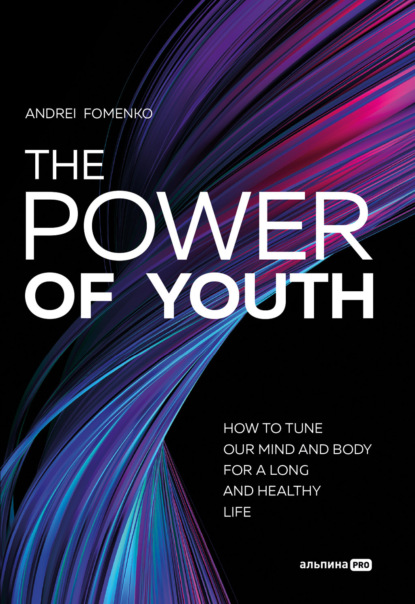По всем вопросам обращайтесь на: info@litportal.ru
(©) 2003-2024.
✖
The Power Of Youth. How To Tune Our Mind And Body For A Long And Healthy Life
Настройки чтения
Размер шрифта
Высота строк
Поля
It was found that people with a positive body image, aware of the principles of its work, experienced more intense feelings from drinking water on an empty stomach, compared to participants with a negative image of themselves and a worse understanding of physiology.
Experts explain that body image refers to thoughts and feelings related to appearance, and positive body image refers to actions based on love for the body, attention, respect, and correct interpretation of its signals. According to scientists, the better human treats and takes care of the body, the better they understand its "language." In turn, increased attention to the signals coming from, for example, the stomach and intestines, allows us to better imagine the processes, to assess the body function higher, and to form a positive body image.
"Our study shows that there is a direct connection between bodily awareness – in this case, the feeling of fullness – and body image," explains lead author Jennifer Todd. "In other words, people who are more aware of body functions, give their bodies a higher rating."
Experts emphasize that the inability to correctly decode internal signals, such as feelings of fullness or hunger, contributes to a negative body image because of an over-reliance on external characteristics related to appearance (e.g., shape and size).
An active lifestyle improves not only the cardiovascular and musculoskeletal system, but also provides protection against many diseases, rejuvenates the body, and prolongs life. Well-chosen workouts improve mood, sleep quality, and blood circulation, and reduce high blood pressure and the risk of heart disease. And even here, variety is great: you can walk, jog, dance, do aerobics, and ride a bike. You must realize that life only happens in motion, so you must move as much as possible.
It is important to know that even the way a human breathes affects their health. Improper breathing is dangerous, because less oxygen enters the lungs, which means that the functions of other organs can be impaired due to oxygen imbalance. The skin condition depends on the lungs: there is a high risk of wrinkles with a violation of gas exchange.
You need to quit bad habits: any addiction leads to physiological and psychological problems. Smoking increases the risk of premature death by 40 %, and smoking one pack a day by as much as 400 %. You should limit your alcohol intake, as excessive consumption of alcohol increases the risk of cancer, heart disease, cirrhosis, and others.
Body health depends firstly on lifestyle. Therefore, it is the human who is fully responsible for the condition of their body. Keeping the body in shape helps to prevent the development of many diseases, improve overall health, maintain it, and high activity for years to come.
CHAPTER 5
BRAIN AND NERVOUS SYSTEM
"THE WORLD IS SMALL, BUT THE HUMAN BRAIN IS IMMENSE," WROTE THE GREAT GERMAN ROMANTICIST FRIEDRICH SCHILLER IN HIS DRAMA "WALLENSTEIN'S DEATH." "ENGIST DIE WELT, UND DAS GEHIRNISTWEIT" TRANSLATES FROM GERMAN AS "THE WORLD IS NARROW, THE BRAIN IS WIDE." IN TERMS OF LOGIC, IT MAY SEEM ABSURD, SINCE IT IS THE WORLD THAT CAN BE CHARACTERIZED AS "WIDE" AND "IMMENSE," WHILE THE PHYSICAL PARAMETERS OF THE HUMAN BRAIN ARE EASILY MEASURABLE.
Yet we realize that we are talking not just about the organ enclosed in the braincase, but about what it generates: mind, consciousness, something truly immeasurable and spanless, which makes us human.
Brain damage – trauma, tumors, age-related changes – often has severe and sometimes irreversible consequences. And it is not just because the brain has vital centers, controlling something like breathing and heartbeat. Adverse changes in the structures responsible for higher nervous activity often lead to personal degradation and anomie. Loss of memory, cognitive powers, and full communication "turn off" the person from society, leaving them to a helpless existence. That is why maintaining brain health, preventing age-related disorders, and slowing their progression is a priorities for people who intend to live happily ever after.
HOW DOES HUMAN NERVOUS SYSTEM WORK?
The human nervous system consists of central (CNS) and peripheral (PNS) systems. The CNS consists of the brain and spinal cord, and the PNS consists of nerves "supervising" the work of each cell in the body. The main task of the nervous system is to combine the work of all body organs, tissues, and cells into a harmonious "mechanism," as well as to provide a rapid and adequate reaction to changes in the internal and external environment. The nervous system works in close tandem with the endocrine (hormonal) system, forming a neuroendocrine system that regulates the entire body with nerve impulses and special chemical matters – hormones.
BRAIN
The brain is the supreme commander of the nervous system, controlling the entire body. In addition, its unique structure of it is the basis for the higher mental functions that underlie consciousness. The brain weighs only 1.2–1.4 kg, representing an average of about 2 % of the human body weight. The male brain generally is 10–12 % heavier and 10 % bulkier than the female brain[48 - Zaidi Z. F. Gender Differences in Human Brain: A Review. The Open Anatomy Journal. 2010;2:37–55. https://benthamopen.com/AB-STRACT/TOANATJ2-37.].
The brain consists of several divisions.
● The largest part of the human brain is the forebrain. The cerebral cortex is a part of it. Both hemispheres (right and left) are divided into four lobes: frontal, occipital, temporal, and parietal. The cerebral cortex is responsible for the perception of all information coming from the external and internal environment: visual, auditory, olfactory, gustatory, and somesthetic cortices are located here. The cortex is also responsible for the human higher nervous activity, including thinking and speech.
● The midbrain contains the visual and auditory centers, which are responsible for processing impulses from the corresponding analyzers. In addition, the midbrain has a tremendous impact on the cerebral cortex. If the cortex is the "consciousness realm," then the midbrain is the "kingdom of the subconscious." The processes occurring in the midbrain can stimulate or inhibit the processes occurring in the cortex. There is also dopamine, a neurotransmitter that plays a key role in the formation of motivation, healthy habits, and addiction, is synthesized.
● The diencephalon mediates the transfer of stimuli to the hemispheres and helps adapt adequately to environmental modifications. Regulates the work of metabolic processes and endocrine glands. Manages the cardiovascular and digestive systems. Regulates sleep and wake, water, and food intake.
● The cerebellum is a brain region that is primarily responsible for maintaining balance and load distribution between muscles, unconscious body skills, and bodily memory.
● The medulla oblongata is an extension of the spinal cord. Nerve pathways that carry information from the whole body and back pass through it, as well as breathing and blood flow control centers. Damage to the medulla oblongata leads to quick death. It is connected to the overlying parts of the brain by the pons, part of the brain stem.
NERVE CELLS
The main structural unit of the central nervous system is the nerve cell or neuron. Neurons consist of a body and several projections. Nerve cell bodies form the gray matter of the brain and spinal cord, and the long myelin-covered projections form the white matter. Gray matter forms the cerebral cortex and the underlying nuclei, and the white matter forms the nerve pathways – a kind of "wires" through which different parts of the brain and other structures "communicate."
At last count, the number of neurons in the cerebral cortex is 14–16 billion, while in the cerebellum is 55–70 billion[49 - Von Bartheld C. S., Bahney J., Herculano-Houzel S. The search for true numbers of neurons and glial cells in the human brain: A review of 150 years of cell counting. J Comp Neurol. 2016;524(18):3865–3895. doi:10.1002/cne.24040.].
The neuron body contains many fibers that form the cytoskeleton: it helps the nerve cell to keep its shape. It also forms some sort of "tracks" where vesicles with neurotransmitters are delivered to the ends of the projections. There are two types of projections – short (dendrites) and long (axons). Most often, neurons have many dendrites and only one axon.
Axons can transmit nerve impulses over long distances – to other brain structures, to the spinal cord and to target organs. As a rule, several neurons located above or below the "author" of the impulse are involved in impulse delivery from the brain to the "distant regions" and back.
Axon terminals approach the body of the next chain member, releasing a neurotransmitter into the gap between the terminal and the body (or projection) of the other neuron. These "meeting places" are called synapses[50 - Synapses are divided into chemical, electrical, and mixed. – Ed. note.]: this is where the electrical impulse is converted into a chemical. The next neuron "receives" the chemical signal and converts it again into an electrical one, sending an impulse to its destination.
Sometimes there are several such "stop-overs" on the way of "agents" to the destination – this system makes it possible to maintain a high intensity of the impulse, not allowing it to fade away. Axons are covered with myelin sheath, which is like an electrical insulator. Myelin consists of glial cells, as will be discussed later. Short projections of neurons – dendrites – help to set "local communication" between neurons. They are myelin-free. Each neuron is connected to thousands and tens of thousands of other neurons and target cells with short and long projections.
NEUROGLIA: THE BRAIN'S LIFE SUPPORT AND DEFENSE SYSTEM
Besides neurons, the "base" cells of the brain, the nervous system includes auxiliary structures – glial cells. There are several types of glial cells: for example, astrocytes, oligodendrocytes, microglia, and microglia. For many years the number of glial cells was believed to be exceeding the number of neurons by 8–10 times, but nowadays, it is proved that the ratio of neurons and glial cells is approximately the same[51 - Von Bartheld C. S., Bahney J., Herculano-Houzel S. The search for true numbers of neurons and glial cells in the human brain: A review of 150 years of cell counting. J Comp Neurol. 2016 Dec 15;524(18):3865–3895. doi:10.1002/cne.24040. Epub 2016 Jun 16. PMID: 27187682; PMCID: PMC5063692.].
Glial cells are involved in the formation of the blood-brain barrier, a filter protecting the brain from microbes, some cells, and toxins. Glial cells also form the microenvironment around neurons, transport nutrients to nerve cells, excrete waste, form myelin sheaths, etc.
FUN FACT
HOW THE "INTESTINAL BRAIN" AFFECTS THE ENTIRE BODY
The human intestine contains a unique cluster of nerve cells – the enteric nervous system (ENS). Sometimes it is also called the intestinal or "abdominal" brain. The ENS uniqueness, its difference from the nerve clusters in other organs, is associated with several characteristics. Firstly, it includes about half a billion neurons! Secondly, the ENS is very similar in structure to the brain. Several types of neurons can receive and send signals and provide the motor function of muscles. The enteric nervous system has its glial cells, which, as in the brain, nourish neurons and activate immune mechanisms. Thirdly, a huge number of neurotransmitters are synthesized in the intestine. The spectrum of the internal neurotransmitters in the ENS is as wide as in the central nervous system. Over 90 % of serotonin and 50 % of dopamine are synthesized in the body being produced in the intestine. Almost all ENS neurotransmitters are of bacterial origin.
All these factors underlie the fourth key feature of the ENS: its autonomy. Unlike other parts of the nervous system, the intestinal brain can function without control by the central and peripheral nervous system, even with extensive brain injury. At the same time, the brain, and the intestine nervous system are closely linked, forming the "gut-brain" axis[52 - The gut-brain axis includes the entire pool of intestinal microorganisms (microbiota), the "intestinal brain" and the central nervous system. – Ed. note.]. Therefore, the ENS not only regulates the digestive tract but also affects the entire body.
Studies show that some diseases affecting the brain, such as Parkinson's disease, are associated with certain changes in the intestinal microbiota.
Scientists at Washington University reviewed 150 studies and found that age-related loss of glial cells (pericytes), which form the blood-brain barrier, significantly increases the risk of developing Alzheimer's disease[53 - Banks W. A., Reed M. J., Logsdon A. F., et al. Healthy aging and the blood-brain barrier. Nat Aging. 2021;1:243–254. doi:10.1038/s43587-02100043-5.].
Glial cells in the blood-brain barrier act as "pumps" that remove toxic beta-amyloid proteins from the brain. Clusters of these proteins are one of the causes of Alzheimer's disease. Disruption of the "pump," caused by age-related loss of glial cells, increases the risk of dementia. Scientists believe that due to a decrease of glial cells in the blood-brain barrier during aging, the brain starts, figuratively speaking, to "leak out," which contributes to cognitive impairment.
SPINAL CORD
The spinal cord is part of the human central nervous system and an extension of the brain. It is in the spinal canal and has the form of a long rod, which extends from the medulla oblongata. The rod center contains a spinal canal filled with cerebrospinal fluid. The central part of the spinal cord is represented by gray matter formed by the bodies of neurons, around which there is white matter formed by the long neuron processes.
White matter consists of nerve pathways through which impulses travel from the brain to the spinal cord (descending tract) and back (ascending tract). That is how different parts of the spinal cord come into contact. Gray matter contains sensory and motor neurons. Their projections connect and form sensory and motor roots, which also connect and form spinal nerves.
The spinal cord performs a conductive function – it is a link between the brain and the peripheral nervous system. At the same time, the spinal cord regulates some processes independently, without the direct involvement of the brain. For example, when we touch a heating object, we pull our hand back automatically. This reflex is formed at the spinal cord level – the movement occurs unconsciously.
NERVES (PERIPHERAL NERVOUS SYSTEM)
A total of 31 pairs of spinal nerves depart from the spinal cord – at the level of each vertebra. All spinal nerves contain sensory fibers, neuron projections that collect information from tactile, pain, temperature receptors of the skin, etc., and send it for "processing" to the central nervous system. They also contain motor fibers through which impulses from the brain and spinal cord travel to the muscles, making them contract.
As they move away from the spinal cord, the roots begin to branch, forming nerve trunks, large nerves, and then dividing into smaller ones. Each nerve ends with a nerve ending near a specific body part. All nerves divide into motor, sensory, and mixed (containing both types of projections) ones.
A separate group consists of 12 pairs of cranial nerves. The bodies of neurons, which projections form the cranial nerves, are part of the special clusters of gray matter, the nuclei of the brain stem. They go beyond the periphery from openings in the skull, and the areas they "work with" do not extend beyond the head and neck. The only exception is the vagus nerve, which plays a crucial role in regulating the work of internal organs.
The peripheral nervous system is divided into autonomic and somatic. The somatic nervous system regulates the functioning of the skeletal muscles, which are responsible for movements that we consciously control. The autonomic nervous system regulates the living environment, which is beyond our consciousness. These include breathing, heartbeat, sweating, etc.
For example, when we face any danger, the autonomic nervous system first activates: the pulse and breath quicken, cold sweat appears, and the muscles turn rigid. All these reactions are unconscious. And then the somatic nervous system comes into play: we decide "fight or flight" by giving the appropriate orders to our skeletal muscles.











